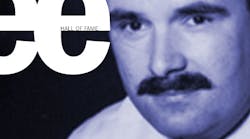Editor’s Note: Hans Camenzind was selected for the Engineering Hall of Fame in our inaugural induction, which appeared in our 50th Anniversary issue in 2002. He died on August 8, 2012. His son, Peter, has summarized his career for us.
Hans Camenzind is well known for the design of the 555 timer, but he accomplished much more in his lifetime. A restless entrepreneur, he was constantly looking for the next project that would keep him intellectually challenged and was not bound by the constraints of his chosen field. He also never stopped coming up with new ideas and interests.
In 1969, he introduced the phase-locked loop concept to integrated circuits (A.B. Grebene, H.R. Camenzind, “Phase Locking As A New Approach For Tuned Integrated Circuits,” ISSCC Digest of Technical Papers, pp. 100-101, Feb. 1969).
In 1971, he struck out on his own and formed a company around his new idea of semi-custom ICs, eventually growing the company to around 150 employees. The idea was pretty revolutionary at the time, reducing from six months to three weeks the time required to get first prototypes of a new component design.
After selling InterDesign in 1977, he pursued his passion of reading and research. Then, after several years researching the origins of religion, he published Circumstantial Evidence.
New Success
In the early 1980s, he started another company, Tridar, to design and build a phone that would work both as a handheld phone and a speakerphone. That company, unfortunately, did not succeed.
In the latter half of the 1980s, he decided to once again pursue semi-custom IC design and formed Array Design to design and market the 700 series. One thing that was interesting about his efforts was that he was able to accomplish by himself, using integrated-circuit CAD tools, what previously required a small company.
After the 700 series was established, he enjoyed doing designs for individual projects. Toward the end of his career he limited his design work to projects he felt served a greater good and did not charge for his work. At one point in the mid-2000s, he told me that his last 15 designs were perfect the first time and did not require any revisions. He had become incredibly skilled in his design abilities.
In the early 2000s, he started working on Designing Analog Chips, because he felt there wasn’t a good text available for today’s digital design engineers that would help them understand analog design. His intention from the start was to give the book away.
For years, he had enjoyed researching the history of the luminaries in the field of electronics and had amassed quite a library of vintage books and first editions on the topic. With his last book, Much Ado About Almost Nothing, he wanted to put the years of research down in a compelling story that told the history of man’s interaction with the electron and all the characters involved.
And, he was a passionate researcher of Nicola Tesla and on several occasions gave lectures on his life and accomplishments.
Some sources have said that he designed the 555 timer 1970, but he really designed it in 1971. Also, he designed the 555 timer on contract with Signetics after he had left and started InterDesign. Payment for the development was in the form of half his salary for a year and the loan of all the electronic equipment he needed. The contract provided valuable income while he was getting the business started.

